
Lorraine concept designs
Developer: Amiga Inc.
First seen: September 2000 (Vintage Computer Festival v4.0) |
The pre-Commodore years evoke a strange nostalgia among Amiga fanatics. A large
portion of this nostalgia is a rememberance of a by-gone era - a time when the
computing market was in its infancy and gameplay was the most important element.
Since the launch of the Amiga 1000, the creation story of the first Amiga -
forged on the workbench of Jay Miner - has been spread among the collected masses.
Throughout the years of Commodore's mismanagement the original Amiga Inc. was
promoted as a beacon that represented Amiga in its purist form - a machine that
was head and shoulders above its contemporaries. The story took on a new impetus
in the post-Commodore years as it developed into the modern conception of the
Amiga. The Commodore chicken head & check mark were out, the Boing ball
was back in fashion! During the last several years numerous businesses (Gateway,
Amiga Inc, Merlancia & Genesi) have attempted to tap this nostalgia to promote
their own business plan and prove that their respective products are the modern
incarnation of the original Amiga.
At the Vintage Computer Festival v4.0 show in September/October 2000 Dale Luck
revealed previously-unknown concept designs for an Amiga PC unit. Similar to
the Atari concepts of the early 1980s the designs are outlandish when compared
to the modern desktop PC. Many of these designs look like a retro attempt at
a stacker unit rather than a home computer - a novelty that adds to their charm.
I would like to thank James Willing for presenting these concept designs on
the Internet.
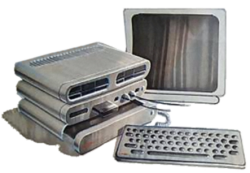 |
Amiga PC: Curved stack design
A modular approach to computing design that is oddly reminiscent of contemporary
stackable USB devices available. The machine is divided into three units
- 2x 5 1/4 floppy disk drives on top, an I/O unit (Input/Output) unit
for game controllers & cartridge slot in the centre, and an unidentifyable
unit at the bottom. It is possible this was intended as a motherboard
unit, but the ability to slide the front open suggests this was not the
aim. An early attempt at a keyboard dock?
|
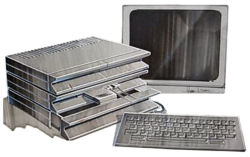 |
Amiga PC: The next generation VCS
Similar to the curved appearance of the above concept design, the second
divides the machine into three distinct sections. However, the diagram
lacks features that could be used to identify the top & bottom units.
Only the middle unit is identifyable, showing a cartridge & game controller
slot. The design is reminiscent of the Atari VCS (2600) console, demonstrating
the Amigas lineage to the Atari 8-bit.
|
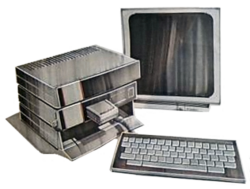 |
Amiga PC: Black stacking unit
An evolution of the previous two designs. The machine lacks obvious controller
ports, but introduces the keyboard garage as a feature. |
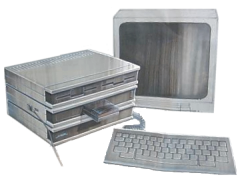 |
Amiga PC: The next generation P.E.T.
The Commodore PET appears to be the primary influence for the 4th concept
design. The shading suggests the case would have been a cream colour with
a black front. Notably, the Amiga logo can be seen on the bottom-left
corner of the case.
|
| Once the final design for the Amiga Lorraine had been chosen,
several variations on the theme were modelled. The keyboard garage had become
a major feature, hence its inclusion in all variations. These retained the
stacked appearance of the previous stage, but had a noticeable colour change
to white (or off-white) and the removal of an obvious cartridge port. |
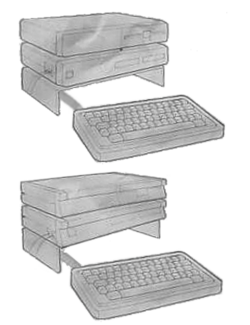 |
Amiga PC, variation 1 & 2
The first image is interesting, showing the first appearance of the unique
A1000 floppy drive moulding. Although this has been designed to protect
a 5 1/4 drive, the curved design would become an identifying feature of
early Amiga disk drives. The keyboard mould has changed to take into account
the small size required to fit it underneath the main unit.
|
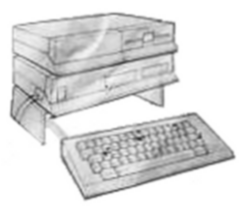 |
Amiga PC, variation 3
A slightly different version of the previous concept designs. The two
rectangular objects below the floppy drive remains a mystery. Were these
cartridge ports or additional drive bays?
|
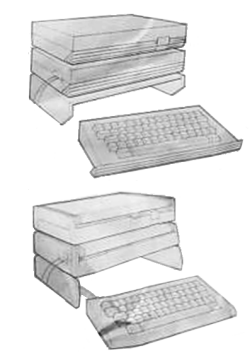 |
Amiga PC, variation 4 & 5
A slightly different interpretation of the classic Amiga 1000 design.
The top image shows colouring fans and a case design influenced by early
IBM PC cases (but remains sleek). The keyboard has also been modified
to create a transparent appearance when it is fitted into the garage.
This design would have raised the keyboard slighly, providing poor egonomics.
Of course, the design was probably rejected because of financial reasons...
|
Original Images
The original photos that the above graphics were taken from can be found below:
Amiga Concept design 1 (49k) | Amiga
Concept design 2 (56k) | Amiga Concept design
3 (68k)
Copyright © 2000 James Willing. Except in the case of
representations of informational, marketing, or promotional material where copyright
remains with the original holder.
BACK
Last Update: 22/12/2002
|












